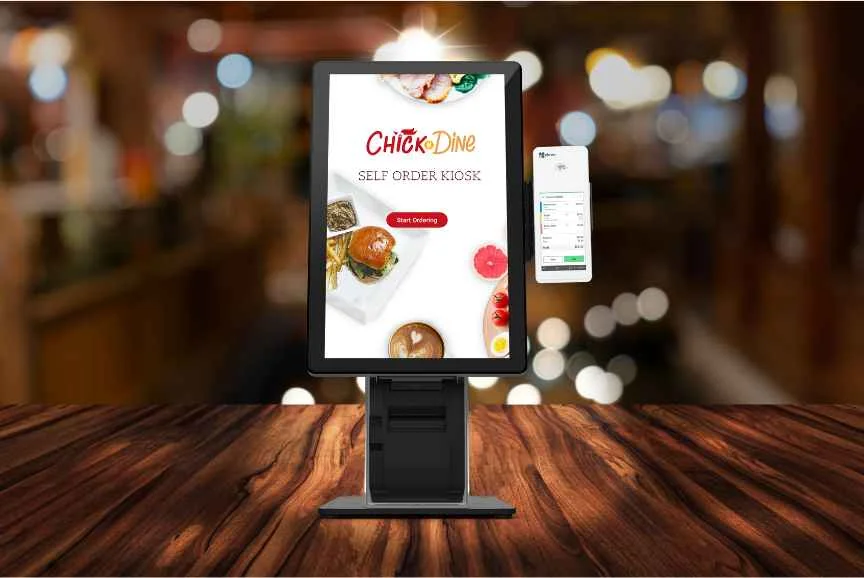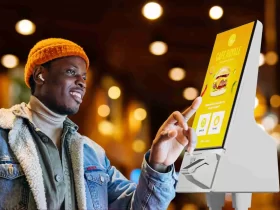Self-serve kiosks are revolutionizing the restaurant industry, offering a myriad of powerful features that not only enhance customer experience but also significantly increase the average ticket size per customer. These kiosks aren’t just another tech trend; they are strategic investments that restaurant owners are using to boost their revenues. In this article, we’ll explore how Self-serve kiosks can be the key to unlocking greater profits for your restaurant business.
Following are the features of Self-serve Kiosks that can increase the Average ticket size of customers.

01. Enhanced User Experience Leads to Bigger Orders
The customer journey begins the moment they approach the Self-serve kiosks. With user-friendly interfaces and visually appealing menus, customers are enticed to explore your full range of offerings. This alone can increase the likelihood of customers adding more to their orders compared to traditional counter ordering.
02. Smart Upselling Increases Revenue

One of the most potent features of Self-serve kiosks is their ability to upsell effectively. Programmed with smart algorithms, these kiosks can suggest complementary items, upgrades, and promotions tailored to the customer’s current selections, encouraging them to ‘supersize’ their order effortlessly.
03. Personalization Attracts Premium Orders
Personalization is key in today’s market, and Self-serve kiosks excel at this. They allow customers to customize their meals down to the last detail. This freedom to personalize not only increases customer satisfaction but often leads to more premium selections, thereby increasing the average ticket size.
04. Reducing Wait Times Boosts Sales

The efficiency of Self-serve kiosks means orders are placed faster, reducing queue times and increasing throughput. This improved speed can lead to more orders being placed in a given time frame, directly contributing to higher daily sales.
Must Read: 5 Benefits of Adding Self-Service Kiosks to Your Restaurant
05. Data-Driven Cross-Selling Techniques

Kiosks collect customer data and order history, which can be used to craft targeted cross-selling strategies. By analyzing ordering patterns, kiosks can make informed suggestions for sides, drinks, or desserts, encouraging customers to indulge in items they are likely to enjoy.
06. Higher Table Turnover with Self-Service
In a sit-down environment, Self-serve kiosks can facilitate higher table turnover by eliminating the wait for a server to take orders. This means more customers served and more chances to increase sales throughout the day.
07. Labor Optimization Lowers Costs

By delegating the order-taking process to kiosks, staff can be redirected to other service areas, reducing labor costs. The savings can then be reinvested into the business, perhaps in marketing efforts to draw even more customers.
08. Accurate Orders Equal Satisfied Customers
Mistakes in order taking can lead to customer dissatisfaction and comped meals. Kiosks minimize this risk by ensuring that orders are entered exactly as the customer intended, resulting in a better experience and less wasted food.
09. Seamless Loyalty Integration Encourages Spending
Integrating loyalty programs with Self-serve kiosks can encourage customers to spend more. With easy access to their rewards and account information, customers are more likely to make purchases that contribute to loyalty points, often leading to larger transactions.
10. Eco-Friendly Practices Attract Conscious Consumers

An added benefit of Self-serve kiosks is their appeal to environmentally conscious consumers. Digital ordering reduces paper waste, and this eco-friendly practice can attract customers who are willing to spend more with businesses that demonstrate a commitment to sustainability.
11. Dynamic Menus for Dynamic Sales
Self-serve kiosks offer the flexibility of changing menu items in real-time. This means you can promote high-margin items or limited-time offers more effectively, enticing customers to spend more than they initially intended.
12. Interactive Nutritional Information Supports Informed Choices
Health-conscious diners appreciate knowing what goes into their food. Kiosks can provide detailed nutritional information at the touch of a button, allowing customers to make informed decisions about their meals. This transparency can encourage customers to opt for premium, healthier options that are often priced higher, thus increasing the average sale.
13. Prominent Display of High-Margin Items

Kiosks can be programmed to highlight high-margin items or meal combos that offer better value for the customer while also increasing profitability for the restaurant. When these items are made more visible, customers are more likely to consider them.
14. Social Media Integration for Enhanced Customer Engagement

Incorporating social media functionality into the kiosk system can turn a regular order into a social event. Customers can check in, share their custom orders, or even post reviews directly from the kiosk. This level of engagement not only enhances the customer experience but also serves as free marketing for the restaurant.
Must Read: Improve Restaurant Dining Experience and Revenue using Self-serve Kiosks
15. Multi-Language Support Broadens Customer Reach
Offering multiple language options on Self-serve kiosks makes the restaurant accessible to a wider audience. When customers can order in their native language, they feel more at ease and are more likely to explore the menu fully, resulting in higher ticket sales.
In the end, the power of Self-serve kiosks lies in their ability to provide a seamless, personalized, and efficient ordering experience that customers love. For restaurant owners, this translates into increased average ticket sizes, better margins, and happier customers. It’s clear that in the competitive world of food service, Self-serve kiosks are not just a convenience but a necessity for growth and profitability.












Leave a Reply